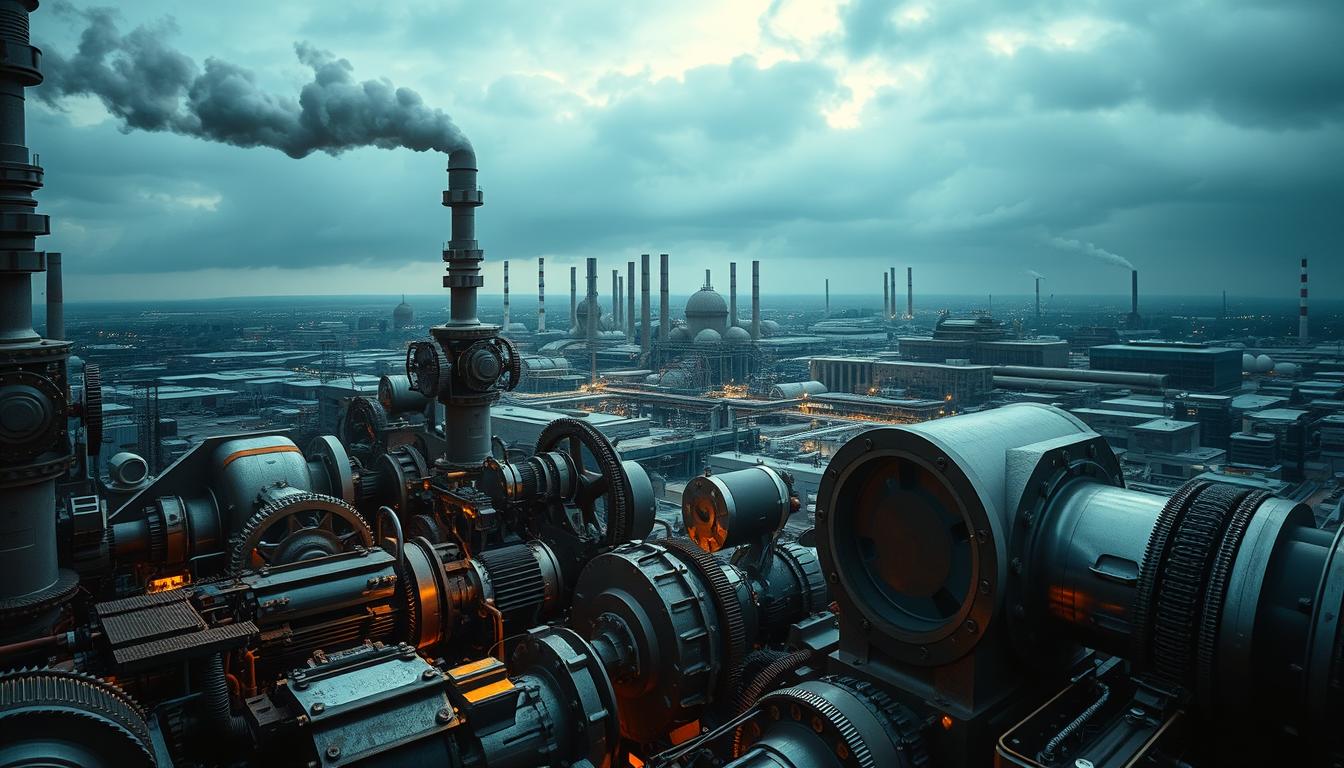In this section, I will explore the key field of engineering thermodynamics. It’s essential for understanding how energy changes and the concept of work in systems. Thermodynamics deals with heat, work, and energy transfer. This helps engineers design and improve mechanical systems.
By understanding energy and work in thermodynamics, we see its big impact on engineering. This introduction sets the stage for a detailed look at thermodynamics’ laws and their uses in the real world.
The Fundamentals of Thermodynamics:
Exploring engineering thermodynamics, I see it’s key to know its basics. Thermodynamics explains how energy, work, and heat relate in physical systems. It’s important to understand the difference between systems, surroundings, and boundaries.
Systems can be open, closed, or isolated. Each type is critical for studying energy and material interactions. State variables like temperature, pressure, and volume are vital. They show how a system acts under different conditions.
By knowing these relationships, I can better analyze processes. State equations come from these properties. They give us a way to solve engineering problems related to energy.
Understanding the Laws of Thermodynamics:
The laws of thermodynamics explain how energy changes in physical systems. The First Law says energy can’t be made or destroyed, only changed. This is important in engineering because it helps us use energy well.
The Second Law talks about entropy, or disorder in a system. It shows that energy spreads out and systems get more disordered over time. This affects how well things like engines and refrigerators work.
The Third Law says that as things get really cold, they can’t get much colder. This idea helps us understand the limits of cold temperatures in physics and engineering.
Applications of Thermodynamics in Engineering:
Thermodynamics is key in many engineering fields, like thermal systems. Heat engines are a big part of this. They turn heat into work, and how well they do this is important.
By knowing thermodynamics, engineers can make these engines better. This means they work more efficiently.
Refrigeration systems also rely on thermodynamics. They move heat from cold places to warm ones. This helps keep things cool, like food and buildings.
Using less energy is a big goal here. It helps save resources and keeps things at the right temperature.
Looking at sustainability, thermodynamics is very important. We need to use energy wisely because of today’s challenges. Engineers work on making systems that use renewable energy sources.
They focus on solar, wind, and geothermal energy. This helps us move towards a greener future.
Key Thermodynamic Processes and Cycles:
I will explore essential thermodynamic processes and cycles that play a key role in engineering. We start with isothermal and adiabatic processes. These processes are vital for work and energy flow in systems.
An isothermal process keeps the temperature constant, making heat transfer efficient. An adiabatic process, on the other hand, happens without heat exchange. It focuses on changes in pressure and volume.
Then, we’ll look at the Otto and Diesel cycles, key in internal combustion systems. The Otto cycle uses spark ignition and works best at certain compression ratios. The Diesel cycle, with compression ignition, is more efficient for heavy fuels and big engines.
Lastly, we’ll examine the Brayton and Rankine cycles, important in power generation. The Brayton cycle is used in jet engines and gas turbines. It compresses air and mixes it with fuel, creating high-temperature exhaust.
The Rankine cycle is used in steam turbines for electricity. It turns thermal energy into mechanical work. Knowing these processes and cycles shows their importance in engineering today.
Future Perspectives in Thermodynamics:
Looking ahead, thermodynamics is set for big changes that could change many industries. New ways to convert energy are being made, using basic thermodynamic ideas. These aim to be more efficient and cut down on pollution.
Things like solar thermal energy and better heat exchangers are leading the way. They help us find cleaner energy options that are good for our planet.
Computational thermodynamics is also making a big impact in engineering. Thanks to better computer models, we can predict how things work better than before. This makes designing and testing new tech easier and faster.
This progress could lead to huge improvements in energy systems. It’s exciting to think about what’s possible.
Thermodynamics is also key in fighting climate change. By using thermodynamic rules, we can create green tech that’s kinder to the environment. Engineers and scientists are working hard to find new ways to tackle climate change.
They’re looking at how thermodynamics can help. This could bring us closer to a greener future.
